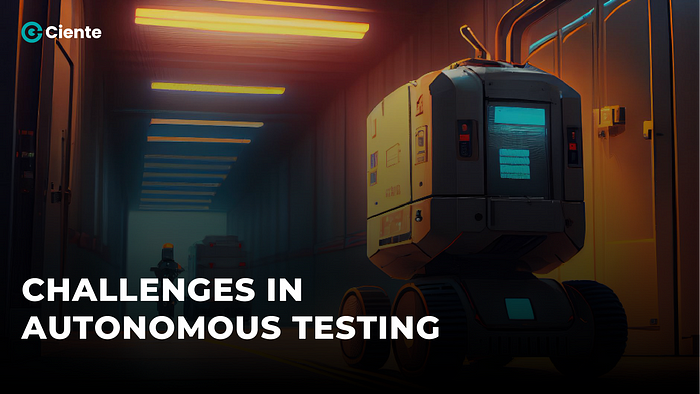Challenges in Autonomous Testing

Strong 8k brings an ultra-HD IPTV experience to your living room and your pocket.
The promise of autonomous testing — using AI and machine learning to streamline software testing — is undeniable. Faster development lifecycles, reduced human error, and comprehensive test coverage all sound like a dream come true for software development teams. However, the road to widespread adoption is riddled with potholes and detours. This blog dives into the key challenges hindering autonomous testing from reaching its full potential.
While the Benefits are Clear…
Traditional testing methodologies, both manual and scripted automation, are time-consuming and susceptible to human bias. Autonomous testing tools offer a solution by:
Accelerating Testing Cycles: These tools can continuously learn and create test cases on the fly, leading to faster feedback loops and quicker development times.
Minimizing Human Error: By automating repetitive tasks, autonomous tools remove human error from the equation, reducing the risk of bugs caused by oversight or fatigue.
Enhancing Test Coverage: Autonomous tools can explore a wider range of scenarios compared to humans, potentially uncovering hidden defects that might be missed in traditional testing.
Challenges Hinder Progress
Despite the advantages, autonomous testing is still in its early stages. Here are some major roadblocks that need to be addressed:
Data Dependence is a Double-Edged Sword: The effectiveness of autonomous testing tools hinges on the quality and quantity of data they’re trained on. Biases in this data can lead to biased tests, potentially missing critical bugs. Strategies like data augmentation and collaboration with domain experts are crucial to ensure unbiased and comprehensive training datasets.
Limited Scope Keeps them in One Lane: Current autonomous testing tools excel primarily at functional testing, focusing on core application functionalities. They may struggle with non-functional aspects like usability and performance testing. A holistic testing strategy should combine autonomous tools with human expertise to address these areas.
False Positives and Negatives: A Confusing Intersection: Autonomous tools can misinterpret unexpected behavior as bugs (false positives). Conversely, they might miss actual defects due to limitations in their learning algorithms (false negatives). Both scenarios necessitate human intervention to analyze results and identify true issues.
Explainability and Trust: A Lack of Transparency Creates a Dead End: The inner workings of autonomous testing tools can often be opaque. It can be difficult to understand why a particular test case was generated or the root cause identified for a failure. This lack of transparency can hinder trust in the testing process. Developers need tools that explain test decisions and highlight areas of uncertainty.
Adaptability to Change: Keeping Up with the Fast Paced Industry: Software applications are constantly evolving. Autonomous testing tools need to be adaptable enough to learn and adjust to these changes to maintain test effectiveness. Continuous learning algorithms are essential to ensure the tools remain relevant as applications incorporate new features or functionalities.
Navigating the Roadblocks: A Multifaceted Approach
Successfully implementing autonomous testing requires a multi-pronged approach:
High-Quality Training Data is the Fuel: Focus on creating diverse and unbiased datasets that accurately represent real-world scenarios. Techniques like data augmentation can be used to enrich existing datasets and mitigate potential biases.
Embrace a Hybrid Testing Strategy: Don’t Ditch the Old Road Entirely: Autonomous testing should not replace traditional methods entirely, but rather work alongside them. Human testers can be involved in setting test goals, interpreting results, and handling non-functional aspects of applications.
Invest in Advanced AI and Machine Learning: Upgrade Your Engine: Developing more sophisticated AI algorithms can improve the ability of autonomous testing tools to handle complex scenarios, reduce false positives/negatives, and provide better explanations for their actions.
Demystify the Process: Make Explainability a Priority: Autonomous testing tools should be designed to provide clear insights into the testing process. This could involve explanations for test case generation, highlighting areas of uncertainty, and offering suggestions for further investigation.
Continuous Learning and Improvement: Keep Evolving with the Technology: Autonomous testing tools should be continuously updated with new data and improved algorithms to ensure they remain effective as applications evolve.
The Road Ahead
Autonomous testing tools hold immense potential for revolutionizing the software development process. By addressing the current challenges and fostering collaboration between AI and human testers, we can pave the way for a future where testing is faster, more efficient, and delivers higher-quality software. As autonomous testing tools mature and overcome these hurdles, they will play a critical role in ensuring the reliability and functionality of the software that shapes our world.
Note: IndiBlogHub features both user-submitted and editorial content. We do not verify third-party contributions. Read our Disclaimer and Privacy Policyfor details.







